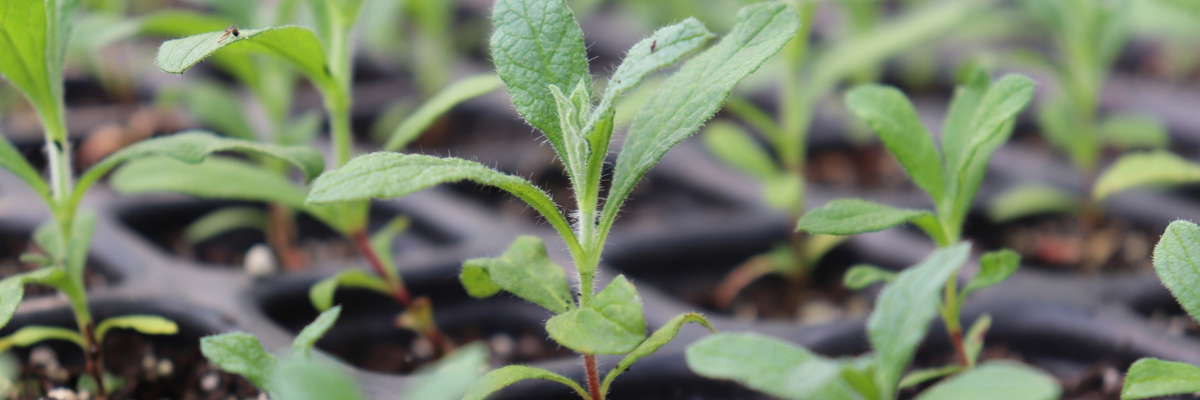What is it about starting seeds that gives us such pleasure?
When you’re itching to get your hands in the soil, but the garden is buried under snow, starting seeds indoors takes the gloom out of chilly winter days. But timing is everything, and you’ll want to create the best schedule for seed-starting success.
You’ll feel immense pride when you share your garden-to-table meals or homegrown floral bouquets with family and friends, knowing that the delicious salad or pretty posy began as tiny seeds grown by you!

When to start seeds
A fresh pile of seed packets makes gardeners itch to get growing. Hold tight: start seeds too early, and you might end up with leggy, overgrown plants that need babying until frost disappears and the garden soil warms. Start seeds too late, and you’ll be drooling over your neighbor’s BLTs while forlornly willing your plants’ blooms to turn into fruit.
So, how do you know when it’s prime time for seed starting?

Tips for timing seed starting
1. Decide what to grow.
Do you drool over homegrown tomatoes? Do you create culinary delicacies with flavorful, fragrant herbs? Or maybe you fill vases with brilliant, homegrown blooms, like celosia. Whatever garden goodies you love, growing them from seed adds emotional satisfaction from start to finish.
Before you sow your first seed, spend some time deciding what you want to grow—and become familiar with that plant’s needs. Does the plant prefer warm temperatures, or can it tolerate a light frost? Knowing the appropriate growing season, temperature, light requirements, and soil needs helps you schedule seed starting.
Some plants, like peppers, tomatoes, and some perennial flowers, benefit from starting seeds indoors, as they need warm temperatures to germinate. By starting these seeds in late winter or early spring, you’ll have hearty, healthy, strong plants ready to go in the garden after the last spring frost.
However, some plants, like beets and carrots, dislike root disturbance, while others, like cucumbers, grow so quickly and easily that it makes sense to direct sow them in the garden. Learning about the preferences of your plants helps you decide which seeds to start indoors—and which ones to direct sow. This is especially helpful if your indoor seed-starting space is limited.
Beginner Tip: Wondering what supplies you’ll need for starting seeds? Take a look HERE for recommendations from the National Garden Bureau.
2. Consider the season.
For many of us, tomatoes, peppers, eggplants, and basil fill our summer garden beds.
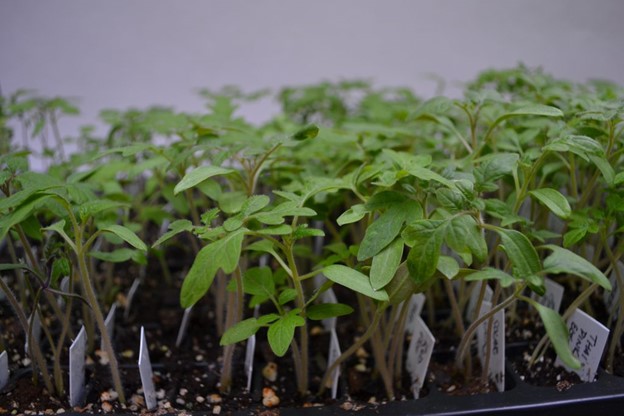
But while summer offers a rich bounty, spring and fall gardens offer equally extensive harvests of cool-season crops, like broccoli and lettuce.
And cool-season flowers, like pansies and snapdragons, fill gardens with color and fragrance, so consider them when planning your floral displays.
When scheduling seed starting, make sure to extend your fresh food and flower harvest by planning to grow in spring and fall, as well as summer. Pick your favorite cool-season foods and flowers and add them to your seed starting list.
3. Check seed needs.
Do you have diva seeds? Some seeds require a bit of pampering before they’re sown for best germination. These prima donnas require more time and effort on your part, but the results are worth it.
Scarification of seeds: A seed with a thick coat can be impenetrable to moisture or gases that trigger germination. In nature, an animal might eat the seed, and its digestive juices break down the seed coat before it passes. Freezing temperatures or microbial activities can also help weaken a tough coat. It’s easy to mimic nature by using a process called “scarification.” Just like the name implies, you’ll “scar” the seed coat, using sandpaper or a nail file to scratch the outer coating, allowing the seed to absorb water and begin germination.
Stratification of seeds: Other seeds, like poppies, require a chilling period before germination, known as “stratification.” Direct sow these seeds in the fall, allowing the winter temperatures to provide the needed cold period.
But what if you forgot to sow seeds until there’s a foot of snow in your garden—or maybe your mild zone doesn’t get a good winter freeze? No worries! Check your seeds’ stratification requirements (because the length of time varies) and use your refrigerator.
Fill a container or bag with perlite, vermiculite, sand, or seed-starting mix. Moisten the mix, add the seeds, and place the container in the refrigerator. (Make sure to mark the seed variety on the container.) Make a note on your calendar when they should be ready for planting. And never let the seeds dry out during stratification.
Soaking seeds: Finally, some seeds like a “soaking” to boost germination. A 24-hour bath in lukewarm water encourages certain seeds with a wrinkled appearance, like nasturtium, to absorb water and begin germination.
So, if you plan to grow any temperamental seeds that need a little TLC for germination, factor in the additional time needed before planting in your seed starting schedule.
Beginner Tip: Some seeds, like tomatoes and peppers, germinate more quickly with the use of a heat mat to warm the soil. Consider adding a waterproof heat mat to your seed-starting supplies to speed germination and shave time off your seed-starting schedule
4. Order Seeds Early
Selecting seeds from your favorite suppliers brightens gray winter days. Don’t be afraid to spoil yourself a bit—order the extra packets of seeds you’re dying to try, whether it’s a new-to-you striped tomato or a gorgeous variety of zinnia.
A small splurge on extra seeds not only gives you a happiness boost when your garden is sleeping, but it’s also a good investment: most seeds remain viable for many years, as long as they’re stored properly. (Keep them in a spot that’s cool, dark, and dry.)
As the catalogs arrive in your mailbox, make yourself a cup of tea or a cocktail, and then enjoy the pleasure of seed shopping.
But—order early for the best selection. You’ll also want to place your order as soon as possible to avoid the shipping crunch of early spring, when the glut of orders may cause a delay in the arrival of your future green babies. By ordering early, you’ll receive your seeds in plenty of time to give them a great start.
Seed Packet Information:
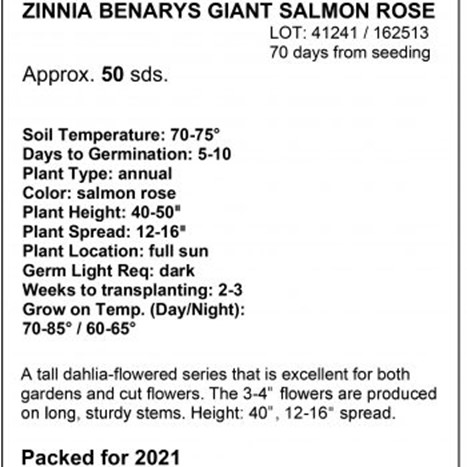
Most seed packets offer excellent information, like days to germination, ideal temperature, how deep to plant the seeds, days to maturity, plant spacing, sun needs, and more.
Make sure to take a look at the information on your seed packets when planning your seed starting schedule. Knowing how long seeds take to germinate and mature helps ensure the best time to start them inside.
Also, some seeds, like lettuce, need to be sown on top of the seed starting mix, as they need light to germinate. And some seeds, like borage, need to be kept in the dark until they sprout. (All seedlings need light as soon as they germinate, though.) Seed packets offer great tips to give your seeds a perfect start.
5. Find your area’s last frost date for spring and first freeze date for fall
One of the most important items for seed scheduling success is knowing your area’s frost dates—the time when it’s safe to plant warm-weather crops in the spring, and the date when the first frost arrives in the fall. Check here to find your frost dates.
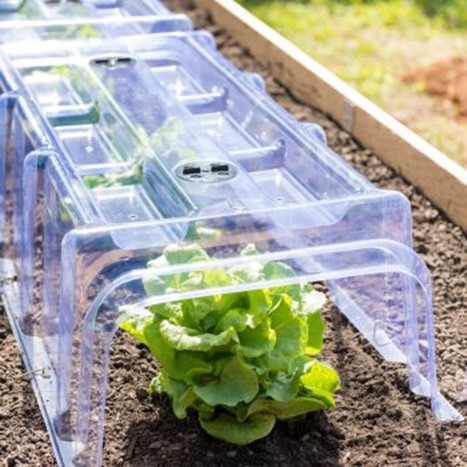
Of course, these dates aren’t foolproof—Mother Nature likes to keep us on our toes—but they’re a good place to start with your seed starting schedule.
Plan around the frost dates but play it safe. For instance, if your last spring frost date is predicted to be April 18, consider waiting an extra week before planting tender crops, like tomatoes, in the garden.
You may also want to keep a frost cover or a few cloches on hand, in case a last cold burst makes an untimely appearance.
After all, you’ve worked hard to nurture those seedlings—and you want to make sure they turn into thriving, healthy, productive plants in your garden.
6. Use a scheduling tool to start seeds.
Once you’ve decided what plants you’ll grow, it’s time to make a seed starting schedule.
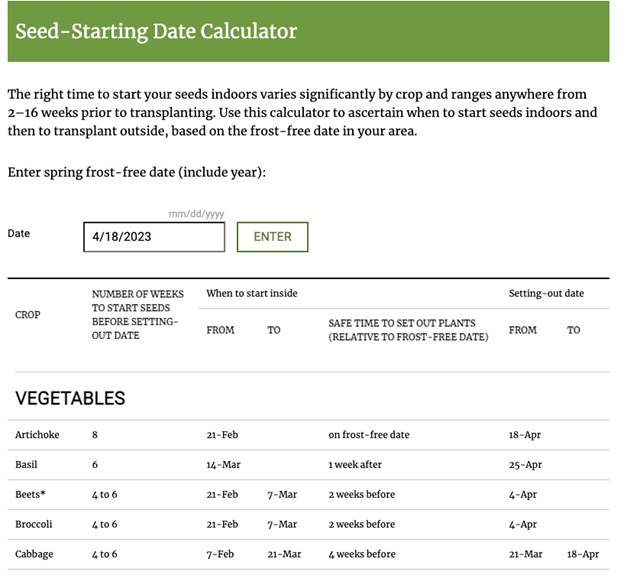
While you can create your own customized spreadsheet, adding in the seeds you want to grow, time to germination, and days to maturity (which you can find on the seed packets), Johnny’s Selected Seeds makes planning easier for you. Johnny’s seed starting calculator gets you growing at the perfect time.
Simply plug in your last frost date, hit enter, and the calculator tells you when to start each type of seed indoors. Easy peasy!
You’ll find a list of fruits and vegetables (from artichoke to watermelon), as well as flowers (from ageratum to zinnia). The calculator shows the number of weeks to start seeds before the setting out date, as well as the safe time to set out plants relative to the frost-free date. You’ll even find notes indicating which seeds should be direct sowed in the garden.
For fall gardens, Johnny’s offers a downloadable spreadsheet that calculates when seeds should be direct sowed or transplants planted in the garden, based on the first frost date in fall.
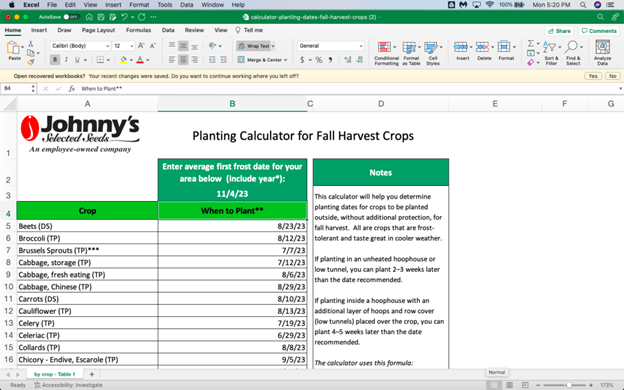
7. Add time for hardening off
Congratulations! You’re the proud plant parent of lush, lovely veggie, herb, and flower plants!
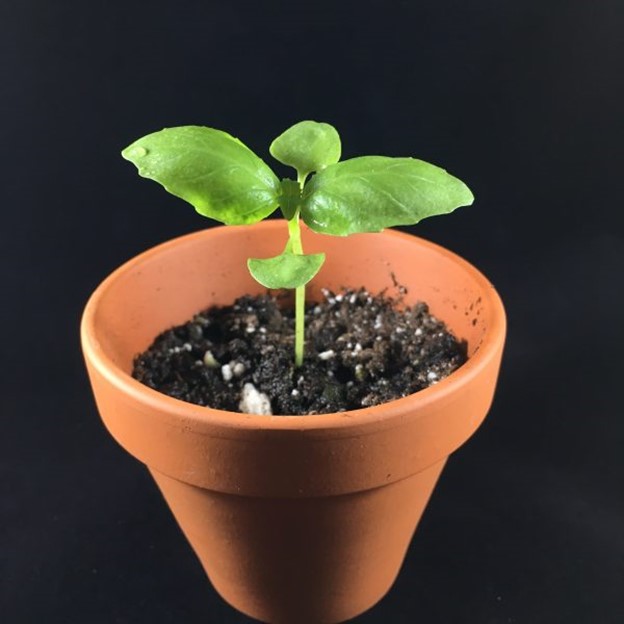
As the weather warms and you’re eager to move the plants into the garden, STOP.
Before you add these carefully pampered plants to the garden, they need to harden off. Hardening off is a process of acclimating young plants grown indoors to outside conditions. Wind, intense sun, rain—your tender plants need to get used to the elements.
Introduce the plants to the outdoors slowly. Look for a level, partially sunny spot in your garden, and give your plants about an hour of outside time. Each day, increase the amount of sunlight they receive until they’re in full sun. Go slowly to avoid sunscald.
If the nights are cold, move the plants inside overnight. Keep them hydrated: wind and sun will make them thirsty. Conversely, if they’ve withstood a rainstorm, make sure to pour standing water out of trays.
When the weather is ideal and the plants have been acclimated to the outdoors for about ten days to two weeks, you can safely introduce your plants into their new garden home.
8. Extend your season with succession sowing.
Some seeds produce quickly and are great for direct sowing in the garden. For instance, radish seeds mature in about a month, making them perfect for succession sowing. Plant them every two weeks, and you’ll have a continuous supply of radishes to enjoy.
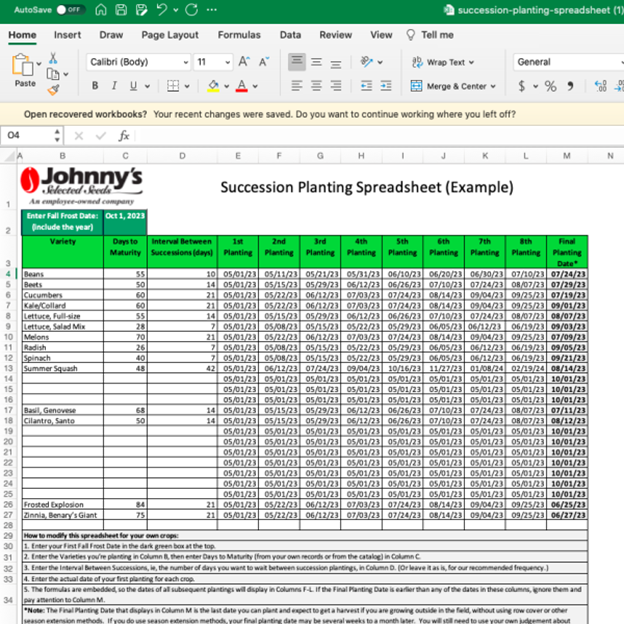
In fact, many vegetables, herbs, and flowers make good candidates for succession sowing, ensuring that you’ll have an ongoing supply of delicious homegrown food and beautiful blooms.
Download Johnny’s Succession Planting Calculator, enter your first frost date, and you’ll find an easy-to-follow succession sowing schedule for your garden.
A little planning goes a long way to ensure happy, healthy seedlings.
You’ll love the satisfaction of creating seed-to-fork dinners for your family and friends, knowing that those carefully nurtured seedlings resulted in a delicious harvest or beautiful homegrown bouquet.
Enjoy your seed-starting adventures!
About National Garden Bureau
Founded more than 100 years ago, the National Garden Bureau educates, inspires, and motivates people to grow home gardens. National Garden Bureau members are horticultural experts, and the information shared with you comes directly from these experts to ensure your gardening success.

